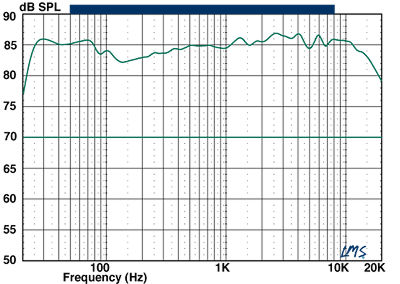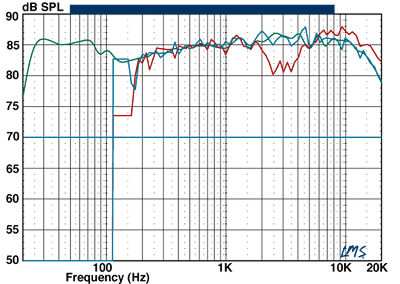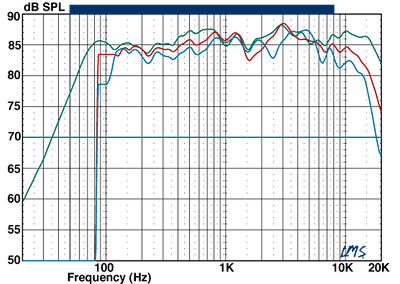NHT VT-3 Home Theater Reference surround speaker system Measurements
The NHT VT-3 Tower's impedance dipped to a minimum of 3.4ohms at 98Hz, and remained below 6ohms between 70 and 220Hz. In the remainder of the frequency range it never dipped below 6ohms; the specified 6ohms impedance is a reasonable value.
The upper portion of the system (minus the onboard subwoofer drivers) is tuned to about 55Hz. The sensitivity measured approximately 85dB (2.83V/m)—slightly below the specified 87dB, but near enough to be accounted for by different measurement techniques.
All curves shown here have 1/6-octave smoothing applied. The average front-axis horizontal response (30° forward angle plus the close-miked woofer response) is shown in Fig.1 (green). Apart from a slight dip in the midbass and a slight emphasis in the low-mid treble, the result is generally very smooth and well-controlled. There is strong bass response evident to 20Hz. We didn't measure the 45° and 60° horizontal off-axis responses because of the system's size, but the horizontal off-axis response up to 30° differed from the average shown here by a loss of only a few dB at the highest frequencies—as might be expected.

Fig.1: VT-3 Tower, 30° horizontal forward angle, average response combined with nearfield woofer response.
Fig.2 shows the same average horizontal response (green) overlaid on the vertical response at 15° above (red) and 15° below (blue) the VT-3 Tower's tweeter axis. Note that you don't want to sit or stand much above the tweeter axis if you want to avoid what should be a clearly audible suckout in the 2-4kHz region. When you audition this system, sit down!

Fig.2: VT-3 Tower, 30° forward angle, average horizontal response combined with nearfield woofer response (green); vertical off-axis responses at +15° (red) and –15° (blue).
The VC-3 Center's impedance measured nearly identically to that of the VT-3 Tower, with the Center's cabinet tuned to 57Hz. The Center's sensitivity measured approximately 86dB (2.83V/m)—close to the specified value.
The VC-3 Center's average front-axis response is shown in Fig.3 (green curve). As in Fig.1, this is the combined, pseudo-anechoic response over a 30° forward angle combined with the woofer's nearfield response. The response is smooth, though marginally less so than the VT-3 Tower's, with a moderate peak at 3kHz. This may add a trace of brightness, though MF apparently heard none. There is also a slight elevation between 400Hz and 1kHz that might push the sound forward a bit. The 45° (red) and 60° (blue) horizontal off-axis curves show no serious suckouts—a problem common in the off-axis responses of many horizontally configured center-channel speakers. The best way to minimize such suckouts is to use a 3-way design with the midrange and tweeter mounted vertically—the configuration used here.

Fig.3: VC-3 Center, 30° horizontal forward angle, average response combined with nearfield woofer response (green); horizontal off-axis responses at 45° (red) and 60° (blue).
Fig.4 shows the VC-3 Center's vertical responses at 15° above (red) and 15° below (blue) the main tweeter axis. The vertical off-axis deviations are minor; in fact, apart from a slight rise at about 10kHz, you could make a case for the below-axis response being smoothest in this case—not a bad thing when the speaker is mounted atop a PTV.—TJN

Fig.4: VC-3 Center, 30° forward angle, average horizontal response combined with nearfield woofer response (green); vertical off-axis responses at +15° (red) and –15° (blue).





























































